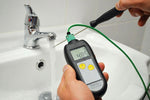
Legionaires' Risks and Reopening Closed Businesses
3 min reading time

3 min reading time
If you are managing a premises with a water system, you have a legal responsibility to identify and manage any risk of legionnaires’. Read on to learn more about the bacteria and to find out what you should do if you are reopening your business after a period of closure.
Leaving the water systems in buildings unused for some time could be fatal if not properly treated upon return. It increases the risk of legionella bacterium, which can be life threatening.
If you are managing a premises with a water system, you have a legal responsibility to identify and manage any risk of legionnaires’. Read on to learn more about the bacteria and to find out what you should do if you are reopening your business after a period of closure.
Legal responsibilities and assessing the risks
If you are the employer or person in control of premises, you must organise a risk assessment from exposure to legionella. The revised Approved Code of Practice (ACOP) Legionnaires’ disease: Control of Legionella Bacteria in water systems (L8) issued by the Government’s Health and Safety Executive (HSE) significantly extends the scope of its guidance on control of legionella bacteria in water. The code applies to all hot and cold water systems in the workplace regardless of their capacity, i.e. the lower limit of 300 litres previously used to exclude domestic systems, no longer applies. Whilst domestic systems may represent a risk, the code only applies to a risk arising from a work activity. This means that all employers, who manage premises with hot/cold water systems and/or wet cooling systems, have a legal responsibility to identify any risk of contamination and to prevent or control it. These records have to be kept for a minimum of five years.
What is legionnaires’ disease?
Legionnaires’ disease is a potentially fatal form of pneumonia. The cause of the disease is a bacterium called legionella pneumophila.
How is it caught?
Legionnaires’ disease is caught by inhaling small droplets of water suspended in the air which contain the legionella bacterium, e.g. spray from showers and taps.
What are the sources of legionella bacterium?
The legionella bacterium is found mainly in stagnant water, e.g. ponds and rivers or buildings containing cooling tower, evaporation condensers, air conditioning and industrial cooling systems, humidifiers, spa baths and hot and cold water systems.

What areas are the most vulnerable?
A wide range of workplaces, but particularly residential accommodation managed privately or by organisations, e.g. local authorities, universities, hospitals, nursing and care homes, housing associations, charities, hostels, private landlords, managing agents, hoteliers and holiday accommodation providers, including guest houses.
Who is most at risk?
People most at risk are people over 45, smokers and heavy drinkers, diabetics and people who are already ill, particularly with chronic diseases or whose immune system is impaired.

source: ETI Temperature Instruments
How can using a thermometer help control legionella in water?
Incorrect water temperature is a key risk factor for legionella growth. The legionella bacteria multiply in water at temperatures between 20 to 45 °C. A typical method of control is to store hot water above 60 °C and distribute it at above 50 °C (care must be taken to prevent scalding). Cold water should be kept below 20 °C.
What action should be taken when reopening a business that has been closed for some time?
The HSE guide to legionnaires’ disease states that:
‘Where a building, part of a building or a water system is taken out of use (sometimes referred to as mothballing), it should be managed so that microbial growth, including legionella in the water, is appropriately controlled.
All mothballing procedures are a compromise between adequate control of microbial growth, the use of water for flushing (while avoiding waste) and degradation of the system by any disinfectant added. Where disinfectants are used, these should leave the system fit for its intended purpose.
The systems should be recommissioned as though they were new (ie thoroughly flushed, cleaned and disinfected) before returned to use.’